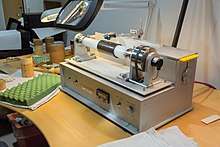Archéophone

The Archéophone is a modern, electric version of the phonographs and ediphones from the 19th and early 20th century. It is specifically designed to transfer phonograph cylinders and other cylinder formats to modern recording media.[1][2]
Designed in France by Henri Chamoux, the machine is used to transfer and preserve recordings at The Library of Congress, the Bibliothèque Nationale de France, Edison National Historic Site,[3] UC Santa Barbara,[4] University of North Carolina,[5] University College Dublin,[6] the Canadian Museum of Civilization and many other libraries and archives. Weighing almost 25 kg and costing over US $10,000, the Archéophone is a specialist's tool and not available to the general public. However, CDs with transferred cylinder recordings have been made available by various record labels and organizations.
See also
References
- ↑ http://65.36.235.139/Merchant2/merchant.mvc?Screen=PROD&Store_Code=NRC&Product_Code=105.060&Category_Code=105%5Bpermanent+dead+link%5D
- ↑ Nationalbiblioteksområdet, in Statsbiblioteket, Aarhus, Denmark. April 2004, vol2, p. 11.
- ↑ Revue du Musée des Arts et Métiers, June 1999
- ↑ http://www-stage.library.ucsb.edu/special-collections/performing-arts/pastudio
- ↑ "Archived copy". Archived from the original on 2009-07-20. Retrieved 2009-04-26.
- ↑ http://www.archeophone.org/dublin_celtic.php
External links